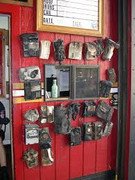I'd say in the last few years I've seen an uptick in ADVs at least between work in Harlem and home in Brooklyn.In reply # 37 "Johnny Gage", mentions how ADV responses were just a single engine company for the FDNY.
Also on occasion, a company returning to quarters etc., would come across an ADV blazing away and just stop to put the fire out.
Basically considered nothing more than an outside rubbish fire.
As a buff, seeing these car fires from blocks away would look like there was a good job going.
But in those very busy years of the 70s and 80s, there was way to many other more serious fires going on and as I remember, a fully involved ADV was on the LOW Priority of getting a company to respond.
Many cars were reported stolen by the owners who were falling behind on their monthly car payments, so they would drop them off, maybe strip them, then either set them on fire themselves, or pay one of the local ghetto guys to set them on fire.
Meanwhile the owner reported the car stolen and collected the insurance.
What was going on back in the early 1970s in NYC began to spread to other cities.
Car fires began to INCREASE in various neighborhoods throughout Connecticut cities beginning in the 1980s
Same story, a suburban car owner reports his car stolen, then later it was found stripped and on fire in one of those cities.
I know of some Engine companies here in Ct where 2 or 3 car fires each night was somewhat routine.
Sometime in the very early 1990s I remember going to an ADV on fire.
As a single engine company we would just put the fire out and have the police respond to locate the owner having it towed away.
One afternoon, while knocking down an ADV fire, I notice the Chief shows up and watches us.
In my mind, I'm actually a little ticked off because I'm thinking; "What's the matter - he doesn't think we can handle this" ?
When the fire is knocked down he calls me aside.
He says to me; "From now on, when you get a car fire, I want you to call a fire marshal"
I said; "Chief for this" ?
He said; "Yes".
At that point, apparently insurance companies were getting tired of paying off these claims and they put pressure on fire departments to have any car fires fully investigated by a fire marshal.
I guess it worked.
These days I see few, if any ADVs.
I can't speak for other places like NYC.
But there's certainly a lot less car fires around a lot of other cities than there was back then.
You are using an out of date browser. It may not display this or other websites correctly.
You should upgrade or use an alternative browser.
You should upgrade or use an alternative browser.
GLORY DAYS VIGNETTES
- Thread starter JohnnyGage
- Start date
- Joined
- Apr 23, 2018
- Messages
- 1,174
THE ERS BOX began to replace the ubiquitous pull box handle fire alarm box in an effort to cut down citywide false alarms. The new gadget has two round buttons on the face of the box with an overlapping hinged cover that covers them. To transmit an alarm, simply lift the cover and press the corresponding button. One button is for the Police Department dispatcher, the other button goes to the Fire Department Boro Communication Office where the dispatcher will ask where and what is your emergency. If you press the FD button and walk away, it is deemed as “NC; no contact” and most likely a 10-92; false alarm. In this case the CO will send just an Engine to investigate instead of a full assignment.
I remember one particular night E 88 responded to over thirty false alarm runs between 1800 hrs and midnight, mostly to 3 or 4 of the same ERS boxes, evidently, still a favorite pastime for bored local neighborhood knuckleheads. But every now and then, it was “surprise, surprise!” when you turned the corner, by yourself, and caught a few windows of flames blowing out.
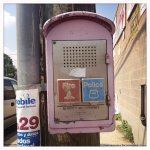
I remember one particular night E 88 responded to over thirty false alarm runs between 1800 hrs and midnight, mostly to 3 or 4 of the same ERS boxes, evidently, still a favorite pastime for bored local neighborhood knuckleheads. But every now and then, it was “surprise, surprise!” when you turned the corner, by yourself, and caught a few windows of flames blowing out.

- Joined
- Jun 27, 2017
- Messages
- 1,516
In NYC through Dec. 11, 12,901 cars stolen, up 32% from the previous year. New Yorkers are getting off easy. In Chicago and Memphis it's up 100%!I'd say in the last few years I've seen an uptick in ADVs at least between work in Harlem and home in Brooklyn.
Auto thieves are now using equipment to reprogram keyless cars to allow them to be opened without damage.
- Joined
- Sep 7, 2020
- Messages
- 2,622
And the penalty for stealing a car is greatly reduced in NYC with no bail for an arrest on the charge.In NYC through Dec. 11, 12,901 cars stolen, up 32% from the previous year. New Yorkers are getting off easy. In Chicago and Memphis it's up 100%!
Auto thieves are now using equipment to reprogram keyless cars to allow them to be opened without damage.
- Joined
- Jun 27, 2017
- Messages
- 1,516
Fallback step one now stop most no-contact alarms. I seem to remember an analysis of thousands of no-contacts alarms years ago. There was only a handful of actual fires and all were reported by telephone within 200 seconds.THE ERS BOX began to replace the ubiquitous pull box handle fire alarm box in an effort to cut down citywide false alarms. The new gadget has two round buttons on the face of the box with an overlapping hinged cover that covers them. To transmit an alarm, simply lift the cover and press the corresponding button. One button is for the Police Department dispatcher, the other button goes to the Fire Department Boro Communication Office where the dispatcher will ask where and what is your emergency. If you press the FD button and walk away, it is deemed as “NC; no contact” and most likely a 10-92; false alarm. In this case the CO will send just an Engine to investigate instead of a full assignment.
I remember one particular night E 88 responded to over thirty false alarm runs between 1800 hrs and midnight, mostly to 3 or 4 of the same ERS boxes, evidently, still a favorite pastime for bored local neighborhood knuckleheads. But every now and then, it was “surprise, surprise!” when you turned the corner, by yourself, and caught a few windows of flames blowing out.
View attachment 28543
- Joined
- Apr 23, 2018
- Messages
- 1,174
ROW FRAME BUILDING FIRES:
These buildings, as the name implies, are built in rows containing as many as twenty or more buildings. They vary in height from two to five stories. These buildings can be considered large rectangular boxes of dry lumber, capable of generating large amounts of heat when burning. There is danger of fire spreading in all directions. When a serious fire burns out the entire first floor, there is danger of collapse.
The critical feature is the common cockloft spreading over all the buildings in the row. The life hazard is great due to the large number of occupants and the rapidity with which the fire may spread. Loss of life may occur within the building, or as a result of the occupants jumping from windows.
For 1st due engine companies, promptly establishing an attack hoseline is paramount. Speed, operating in close quarters, and mobility of operation are of prime importance, all interior hoselines stretched are 1 ¾". The first hoseline should be operating before second lines are stretched.
All FDNY firefighters had to be familiarized with specific assignments and areas of responsibility including variations for; Cellar fire, upper floor fire, building fully involved and extending to exposures, vacant buildings in a row of occupied frames, vacant buildings in a row.
Amazing photo by BC Jack Calderone
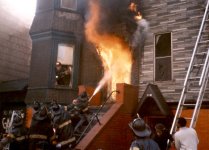
These buildings, as the name implies, are built in rows containing as many as twenty or more buildings. They vary in height from two to five stories. These buildings can be considered large rectangular boxes of dry lumber, capable of generating large amounts of heat when burning. There is danger of fire spreading in all directions. When a serious fire burns out the entire first floor, there is danger of collapse.
The critical feature is the common cockloft spreading over all the buildings in the row. The life hazard is great due to the large number of occupants and the rapidity with which the fire may spread. Loss of life may occur within the building, or as a result of the occupants jumping from windows.
For 1st due engine companies, promptly establishing an attack hoseline is paramount. Speed, operating in close quarters, and mobility of operation are of prime importance, all interior hoselines stretched are 1 ¾". The first hoseline should be operating before second lines are stretched.
All FDNY firefighters had to be familiarized with specific assignments and areas of responsibility including variations for; Cellar fire, upper floor fire, building fully involved and extending to exposures, vacant buildings in a row of occupied frames, vacant buildings in a row.
Amazing photo by BC Jack Calderone

- Joined
- Apr 23, 2018
- Messages
- 1,174
Captain Bob Gass covered in L 38 for a brief period when he was promoted, yet made a lifelong impression. I worked with him a handful of tours, he seemed calm, cool, collected and confidant, circa 1986. The FDNY was blessed to have leaders of his calibre. He'd sit back and observe the kitchen table shenanigans with a smile. And, he knew his stuff on the fire floor. As a young gun, these leaders became our mentors, skilled and accomplished that we strived to emulate. I would have loved working more with him, to get a spot as company commander of E 75 says the type of respected boss he was. And by the way, I think thats one of the coolest last names to have! Salute Cap, where ever you are!


- Joined
- May 6, 2010
- Messages
- 17,442
^^^^^^. I stood next to Bob in proby school...... after Graduation he was assigned to SQ*3 in a FH adjoining me in BKLYN ....he moved up the ranks fast & in a short time he made LT then around '78 or '79 when I was in R*2 on Carlton Ave Bob walked in the door as a CPT covering in 210 for the day....he asked me "did I think there would be some work today ?" ....I said "for the Rescue yes ...for you I don't know"......about an hour later box 387 Park & Carlton came in......Carlton Ave was a single bay FH & that day 210 was parked in front & we were in the back....210 was not even fully out onto the apron & Bob gave a 10-75.....out a few windows of a frame down the block......after he made BC he was in BN*19 .....there was an electrical Fire related response & Bob & the LAD*33 LT Jim Gill (who had been a proby in 108 while I was still there) were in a cellar when a CO buildup in the conduits from the street exploded blowing the large meter pan covering off the wall & hitting & seriously injuring both.
- Joined
- Apr 23, 2018
- Messages
- 1,174
The Outside Vent Man (OVM), had to be an experienced and determined heads up firefighter that worked alone many times. Just getting to the rear fire escape could be a nightmare hopping over fences, dogs, heaping mounds of rubbish. And that was before bunker gear...Attempting to gain entry off the fire escape could be another challenge, check out the inside gate of apartment window.
(Photo credit to the photographer.)
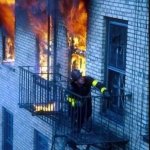
(Photo credit to the photographer.)

- Joined
- Jun 27, 2017
- Messages
- 1,516
I've seen a report that the OVM is the most likely position on the fireground to be awarded a medal.The Outside Vent Man (OVM), had to be an experienced and determined heads up firefighter that worked alone many times. Just getting to the rear fire escape could be a nightmare hopping over fences, dogs, heaping mounds of rubbish. And that was before bunker gear...Attempting to gain entry off the fire escape could be another challenge, check out the inside gate of apartment window.
(Photo credit to the photographer.)
View attachment 28709
- Joined
- Apr 23, 2018
- Messages
- 1,174
Thats true, he's in the position opposite the hoseline by himself, or until the second due OV arrives (except when the TL goes into operation). A lot of decision making.I've seen a report that the OVM is the most likely position on the fireground to be awarded a medal.
Last edited:
Dan, "JohnnyGage", Thank you for telling us the many stories and facts that you have presented to us as members and visitors to this site in your "Glory Days Vigndettes".
You might have had another upcoming popular book, in addition to the soon released book "They Saved New York", if this was in book form.
Your stories and facts are at the TOP OF THE LIST as I see it.
And I'm guessing here, that I have plenty of company who would also agree
THANK YOU Dan.
You might have had another upcoming popular book, in addition to the soon released book "They Saved New York", if this was in book form.
Your stories and facts are at the TOP OF THE LIST as I see it.
And I'm guessing here, that I have plenty of company who would also agree
THANK YOU Dan.
- Joined
- Apr 23, 2018
- Messages
- 1,174
Thanks Willy, I like little concise stories, short and sweet...just like you! More to come.
- Joined
- Apr 23, 2018
- Messages
- 1,174
- Joined
- Apr 23, 2018
- Messages
- 1,174
ROOFMAN; PART 1
Ladder Companies institute a two-team offense covering their area of assigned responsibility guided by the alarm box assignment. The first due ladder company operates on the fire floor and the second due ladder company operates on the floors above. The ladder company is divided into an inside and outside team. The inside team consists of the company officer, the forcible entry fireman and the canman. The outside team consists of ladder chauffeur, outside vent (OV) and roofman (RM).
The outside team is not under the direct supervision of the company officer, and typically requires a more seasoned firefighter, part of their tool assignment is a portable radio to maintain communications with their officer.
The duties of the RM demand a motivated, knowledgeable and adept firefighter capable of decisive action. The RM’s priority is to get to the roof as quickly as possible, and perform vertical ventilation especially on typical flat roof Bronx tenements where smoke, heat and lethal gasses quickly begin to build up on the top floor suffocating anyone above the fire.
As a new member of L 38 Company officers began to appreciate my progression and began assigning me to various positions operating by myself. Tonight I will be working with Lieutenant Pat Welby, he has an unmistakable Irish brogue and oftentimes difficult to understand, he has assigned me the RM position. Lt. Welby is a War Year vet having worked in squad companies during the arson War Years. At times, he comes off gruff and likes to call us young guns in the company kids.
He’s not Mr. Warmth, but more business-like friendly, like an uncle who doesn't like kids. When assigning truck positions to us young guns that require a portable radio he forewarns us in his Irish accent “don’t be callin’ me on der radio fer nuttin’ unless ye’ar dead or somethin’”. Accordingly, the senior man piles on with witty advice, “Just get yer ass up on the roof and if you need a mask, we’ll bring it to you”.
Of all the four truck positions, Roofman was my favorite truck assignment. I appreciated the significant priority, responsibility and urgency attached to the position. During the Bronx Glory Days most of our jobs were in the ubiquitous massive six story apartment houses, many still vacant, and with consistent fire duty in these buildings the repetition afforded me plenty of opportunities to hone my skills and work the bugs out. Receiving tips and pointers from senior men was a huge advantage.
Getting to the roof of a six story tenement the RM had a few decisions and options he had to make quickly. The first option was to take a second separate stairwell in the same building that was in an opposite wing of the reported fire. However, if the two stairwells were connected by a common hallway, this option was nixed. The next choice was to dash up the stairwell in the adjoining apartment house, providing both buildings had the same height so that you could climb over a low parapet wall from one building onto the other. The third option was climbing theaerial If the building was isolated or there was a height difference from the adjoining building. If all else failed, the least desirable method was to scamper up the rear fire escape.
But this was just the start. Next I will divulge the duties, responsibilities, hazards and various procedures of roof operations on tenements, row frames and taxpayers including venting, coffin cuts, trench cuts, and much more in the following series of “ROOFMAN”. Stay tuned!
(PHOTO, RM ascends aerial to vacant apartment house job on Southern Blvd, Bronx 1983ish.)
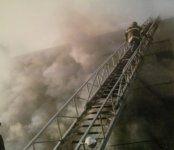
Thanks for reading, hope you enjoyed!
Ladder Companies institute a two-team offense covering their area of assigned responsibility guided by the alarm box assignment. The first due ladder company operates on the fire floor and the second due ladder company operates on the floors above. The ladder company is divided into an inside and outside team. The inside team consists of the company officer, the forcible entry fireman and the canman. The outside team consists of ladder chauffeur, outside vent (OV) and roofman (RM).
The outside team is not under the direct supervision of the company officer, and typically requires a more seasoned firefighter, part of their tool assignment is a portable radio to maintain communications with their officer.
The duties of the RM demand a motivated, knowledgeable and adept firefighter capable of decisive action. The RM’s priority is to get to the roof as quickly as possible, and perform vertical ventilation especially on typical flat roof Bronx tenements where smoke, heat and lethal gasses quickly begin to build up on the top floor suffocating anyone above the fire.
As a new member of L 38 Company officers began to appreciate my progression and began assigning me to various positions operating by myself. Tonight I will be working with Lieutenant Pat Welby, he has an unmistakable Irish brogue and oftentimes difficult to understand, he has assigned me the RM position. Lt. Welby is a War Year vet having worked in squad companies during the arson War Years. At times, he comes off gruff and likes to call us young guns in the company kids.
He’s not Mr. Warmth, but more business-like friendly, like an uncle who doesn't like kids. When assigning truck positions to us young guns that require a portable radio he forewarns us in his Irish accent “don’t be callin’ me on der radio fer nuttin’ unless ye’ar dead or somethin’”. Accordingly, the senior man piles on with witty advice, “Just get yer ass up on the roof and if you need a mask, we’ll bring it to you”.
Of all the four truck positions, Roofman was my favorite truck assignment. I appreciated the significant priority, responsibility and urgency attached to the position. During the Bronx Glory Days most of our jobs were in the ubiquitous massive six story apartment houses, many still vacant, and with consistent fire duty in these buildings the repetition afforded me plenty of opportunities to hone my skills and work the bugs out. Receiving tips and pointers from senior men was a huge advantage.
Getting to the roof of a six story tenement the RM had a few decisions and options he had to make quickly. The first option was to take a second separate stairwell in the same building that was in an opposite wing of the reported fire. However, if the two stairwells were connected by a common hallway, this option was nixed. The next choice was to dash up the stairwell in the adjoining apartment house, providing both buildings had the same height so that you could climb over a low parapet wall from one building onto the other. The third option was climbing theaerial If the building was isolated or there was a height difference from the adjoining building. If all else failed, the least desirable method was to scamper up the rear fire escape.
But this was just the start. Next I will divulge the duties, responsibilities, hazards and various procedures of roof operations on tenements, row frames and taxpayers including venting, coffin cuts, trench cuts, and much more in the following series of “ROOFMAN”. Stay tuned!
(PHOTO, RM ascends aerial to vacant apartment house job on Southern Blvd, Bronx 1983ish.)

Thanks for reading, hope you enjoyed!
- Joined
- Apr 23, 2018
- Messages
- 1,174
ROOFMAN; PART 2
The FDNY has heaps of manuals on fire fighting procedures and tactics. But one book, LADDERS 3 is the essential handbook that all ladder company members and officers must know stone cold. It is the truckies Bible, one of six ladder company reference books written by accomplished ladder company officers in the early 1960’s.
Until the publication of Ladders 3 Fire Fighting Procedures many FDNY ladder companies did not have a standard way of operating at fires especially at a tenement fire which was complex because of its height 5 or 6 stories, interior shaft-ways, and fire escape variation on the front and rear. At that time the tenement was the most common multiple dwelling residence building fire that killed most New Yorkers.
During proby school, Ladders 3 was introduced to us in a controlled environment, but understanding the complexities and comprehending the full essence of truck work takes years of experience to grasp the various details that affect the truck company’s mission. One tenet implied at proby school and drilled into us about the roofman (RM) position was that NOTHING SHALL DETER the member assigned the roof position from carrying out the assigned duties. Meaning that no matter what’s occurring on the fireground, the RM should not be distracted from his duty of hot footing it to the roof. His mission of getting to the roof and performing vertical ventilation will greatly benefit the overall firefighting operation by locating the fire, keeping the fire from spreading and giving victims a chance to survive.
As I previously mentioned, getting to the roof of a six story tenement the RM had a few decisions and options he had to make right away. The first option was to take a second separate stairwell in the same building that was in an opposite wing of the reported fire. However, if the two stairwells were connected by a common hallway, this option was nixed. The next choice was to dash up the stairwell in the adjoining tenement, providing both buildings had the same height and you could climb over a low parapet wall from one building to the other. The third option was climbing the aerial If the building was isolated or there was a height difference from the adjoining building. If all else failed, the least desirable method was to scoot up the rear fire escape.
The RM had to be careful crossing buildings with open light shafts and holes from previous fires and neglect. The RM may encounter other hazards like dogs, uneven roof setbacks, unstable yankee gutters, laundry lines, razor-barbed wire fencing, sloping cornices, snow and ice, and sometimes aggressive druggies.
Upon reaching the roof, the RM immediate mission was to conduct a quick visual survey of the exterior of the building looking for any victim hanging out from a window needing rescue. If there is no stranded victim he’d force open the bulkhead door, reaching in searching for potential victims who may be trapped or overcome behind the door or on the stairway.
Heavy smoke and high heat issuing from the bulkhead doorway would obviously require further ventilation such as removal of the skylight. Removing the skylight over the interior staircase created speedy relief for the advancing engine company. Even removing the skylight we had a particular technique, and that was to pop one pane of glass, pause, and pop out the rest of the skylight. The brief pause after popping the one pane of glass cautioned the troops below that more glass is about to rain down on them, and a cue not to look up.
This was the standard operational plan for all first due RM at tenements throughout the city. There were detailed procedural variations for top floor or cockloft fires, row frame-brownstone buildings and taxpayers that the RM had to recognize and modify his strategy.
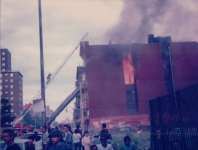
The FDNY has heaps of manuals on fire fighting procedures and tactics. But one book, LADDERS 3 is the essential handbook that all ladder company members and officers must know stone cold. It is the truckies Bible, one of six ladder company reference books written by accomplished ladder company officers in the early 1960’s.
Until the publication of Ladders 3 Fire Fighting Procedures many FDNY ladder companies did not have a standard way of operating at fires especially at a tenement fire which was complex because of its height 5 or 6 stories, interior shaft-ways, and fire escape variation on the front and rear. At that time the tenement was the most common multiple dwelling residence building fire that killed most New Yorkers.
During proby school, Ladders 3 was introduced to us in a controlled environment, but understanding the complexities and comprehending the full essence of truck work takes years of experience to grasp the various details that affect the truck company’s mission. One tenet implied at proby school and drilled into us about the roofman (RM) position was that NOTHING SHALL DETER the member assigned the roof position from carrying out the assigned duties. Meaning that no matter what’s occurring on the fireground, the RM should not be distracted from his duty of hot footing it to the roof. His mission of getting to the roof and performing vertical ventilation will greatly benefit the overall firefighting operation by locating the fire, keeping the fire from spreading and giving victims a chance to survive.
As I previously mentioned, getting to the roof of a six story tenement the RM had a few decisions and options he had to make right away. The first option was to take a second separate stairwell in the same building that was in an opposite wing of the reported fire. However, if the two stairwells were connected by a common hallway, this option was nixed. The next choice was to dash up the stairwell in the adjoining tenement, providing both buildings had the same height and you could climb over a low parapet wall from one building to the other. The third option was climbing the aerial If the building was isolated or there was a height difference from the adjoining building. If all else failed, the least desirable method was to scoot up the rear fire escape.
The RM had to be careful crossing buildings with open light shafts and holes from previous fires and neglect. The RM may encounter other hazards like dogs, uneven roof setbacks, unstable yankee gutters, laundry lines, razor-barbed wire fencing, sloping cornices, snow and ice, and sometimes aggressive druggies.
Upon reaching the roof, the RM immediate mission was to conduct a quick visual survey of the exterior of the building looking for any victim hanging out from a window needing rescue. If there is no stranded victim he’d force open the bulkhead door, reaching in searching for potential victims who may be trapped or overcome behind the door or on the stairway.
Heavy smoke and high heat issuing from the bulkhead doorway would obviously require further ventilation such as removal of the skylight. Removing the skylight over the interior staircase created speedy relief for the advancing engine company. Even removing the skylight we had a particular technique, and that was to pop one pane of glass, pause, and pop out the rest of the skylight. The brief pause after popping the one pane of glass cautioned the troops below that more glass is about to rain down on them, and a cue not to look up.
This was the standard operational plan for all first due RM at tenements throughout the city. There were detailed procedural variations for top floor or cockloft fires, row frame-brownstone buildings and taxpayers that the RM had to recognize and modify his strategy.

- Joined
- Apr 23, 2018
- Messages
- 1,174
HISTORY OF LADDER COMPANY PROCEDURES
LADDERS 3
From Riverdale to Rockaway, from Douglaston to New Dorp, every ladder company firefighter to ride on one of 143 ladder trucks in NYC operates on the same page. As mentioned previously, the genesis of FDNY ladder company operations was developed at the insistence of Fire Chief John O’Hagan after he noticed a photo of two firefighters attempting a precarious rescue.
Chief O’Hagan reached out to highly respected Ladder 26 Captain John O’Regan of Harlem. The photo caused Captain O’Regan to write Ladders 3 and stop the freelancing and give every ladder company firefighter a specific assignment, a location to perform the assignment and a specific tool to carry and perform the assignment.
I went to the mountain top and spoke with Deputy Chief Vincent Dunn about the historical significance of this document. Previously written was Ladders 1 in regards to portable ladders and Ladders 2 that defined placement of aerial ladder companies at fire scenes.
Ladders 3 was to become the foremost ladder company Bible, implemented in the early 1960’s. Here is Chief Dunns account:
“Captain O’Regan contribution was the revolution of how FDNY ladder companies worked at tenement fires. In the 1960s as a firefighter in Ladder 30 and Ladder 26 John O’Regan established a systems approach to ladder company operation at tenement fires called Ladders 3; Firefighting Procedures at tenement fires.
Based on his firefighting experience he identified the exact assignment location, the firefighting tools to carry and how to operate necessary for every firefighter responding to a tenement fire. The standard method of operating for ladder companies was groundbreaking. It was unheard of in the FDNY.
At that time there was no organized firefighting procedure for ladder companies. One of his changes in firefighting at tenement fires was very controversial. The roof assignment, getting to and venting the roof over the tenement stair was taken from the tiller firefighter and assigned another firefighter from the side step. O’Regan reasoned the tiller firefighter had to maneuver the ladder truck with the chauffeur to get the turntable into the proper position and this would delay his trip to the roof. The roof venting was too important to the operation to be delayed.
Until the publication of Ladders 3 many ladder companies in the FDNY did not have a standard way of operating at fires especially at a tenement fire which was complex because of its height 5 or 6 stories, interior shaft-ways, and fire escape variation on the front and rear. At that time the tenement was the most common multiple dwelling residence building fire that killed most New Yorkers.”
Ladders 3 became the bedrock of ladder company operations. Subsequent books that followed, Ladders 4 Private Dwellings, Ladders 5 Brownstone and Row frame buildings were modified from Ladder 3 yet still retained the salient features.
Ladders 3 went through numerous revisions. Beforehand, many firefighters preferred to carry an ax, but the hook was recommended instead because there was no other tool that was handy to check for fire extension.
The other big contention was the Tillerman position. The Roof firefighter was not the tillerman. Previously, Captains of ladder companies ran their company their way and preferred the roofman to tiller. This new procedure took the decision out of the Captains hands, and many were not happy. But, the roofmans duties required him to immediately attain the roof. During this time, ladder companies were tractor trailers and the tillerman had to hold back and place the apparatus turntable in optimum position and then help the chauffeur screw down jacks. One of the original primary reasoning behind, “ NOTHING SHALL DETER the member assigned the roof position from carrying out the assigned duties.”
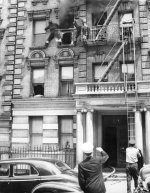 Thanks for reading, hope you enjoyed the little history!
Thanks for reading, hope you enjoyed the little history!
LADDERS 3
From Riverdale to Rockaway, from Douglaston to New Dorp, every ladder company firefighter to ride on one of 143 ladder trucks in NYC operates on the same page. As mentioned previously, the genesis of FDNY ladder company operations was developed at the insistence of Fire Chief John O’Hagan after he noticed a photo of two firefighters attempting a precarious rescue.
Chief O’Hagan reached out to highly respected Ladder 26 Captain John O’Regan of Harlem. The photo caused Captain O’Regan to write Ladders 3 and stop the freelancing and give every ladder company firefighter a specific assignment, a location to perform the assignment and a specific tool to carry and perform the assignment.
I went to the mountain top and spoke with Deputy Chief Vincent Dunn about the historical significance of this document. Previously written was Ladders 1 in regards to portable ladders and Ladders 2 that defined placement of aerial ladder companies at fire scenes.
Ladders 3 was to become the foremost ladder company Bible, implemented in the early 1960’s. Here is Chief Dunns account:
“Captain O’Regan contribution was the revolution of how FDNY ladder companies worked at tenement fires. In the 1960s as a firefighter in Ladder 30 and Ladder 26 John O’Regan established a systems approach to ladder company operation at tenement fires called Ladders 3; Firefighting Procedures at tenement fires.
Based on his firefighting experience he identified the exact assignment location, the firefighting tools to carry and how to operate necessary for every firefighter responding to a tenement fire. The standard method of operating for ladder companies was groundbreaking. It was unheard of in the FDNY.
At that time there was no organized firefighting procedure for ladder companies. One of his changes in firefighting at tenement fires was very controversial. The roof assignment, getting to and venting the roof over the tenement stair was taken from the tiller firefighter and assigned another firefighter from the side step. O’Regan reasoned the tiller firefighter had to maneuver the ladder truck with the chauffeur to get the turntable into the proper position and this would delay his trip to the roof. The roof venting was too important to the operation to be delayed.
Until the publication of Ladders 3 many ladder companies in the FDNY did not have a standard way of operating at fires especially at a tenement fire which was complex because of its height 5 or 6 stories, interior shaft-ways, and fire escape variation on the front and rear. At that time the tenement was the most common multiple dwelling residence building fire that killed most New Yorkers.”
Ladders 3 became the bedrock of ladder company operations. Subsequent books that followed, Ladders 4 Private Dwellings, Ladders 5 Brownstone and Row frame buildings were modified from Ladder 3 yet still retained the salient features.
Ladders 3 went through numerous revisions. Beforehand, many firefighters preferred to carry an ax, but the hook was recommended instead because there was no other tool that was handy to check for fire extension.
The other big contention was the Tillerman position. The Roof firefighter was not the tillerman. Previously, Captains of ladder companies ran their company their way and preferred the roofman to tiller. This new procedure took the decision out of the Captains hands, and many were not happy. But, the roofmans duties required him to immediately attain the roof. During this time, ladder companies were tractor trailers and the tillerman had to hold back and place the apparatus turntable in optimum position and then help the chauffeur screw down jacks. One of the original primary reasoning behind, “ NOTHING SHALL DETER the member assigned the roof position from carrying out the assigned duties.”
 Thanks for reading, hope you enjoyed the little history!
Thanks for reading, hope you enjoyed the little history!Dan, years ago I remember going out to The Rock and for a small fee, I was able to buy those FDNY manuals.
There was Engine Company Operations and Ladder Co operations, which included the Ladders Operations 1, 2, 3, etc that you mention.
There was also one or two Administrative manuals regarding such things as house watch, basis safety operations, uniforms, etc.
I'm not sure of the titles, but I do remember something of that nature.
Also as I remember, there were updates and those updates would come out every three months.
When it came to training manuals, those booklets were the BEST I'VE Ever Seen.
Although they were based on the FDNY operations, there was a wealth of information that could be applied to basically any fire department in the country.
My first manual was given to me by Chief Sacramano (spelling ?) who was in charge of The Rock way back in maybe the late 70s or early 80s.
The manual he gave me was the thick "FDNY Probie Manual".
He told me that the Probies must learn this cover to cover.
There was Engine Company Operations and Ladder Co operations, which included the Ladders Operations 1, 2, 3, etc that you mention.
There was also one or two Administrative manuals regarding such things as house watch, basis safety operations, uniforms, etc.
I'm not sure of the titles, but I do remember something of that nature.
Also as I remember, there were updates and those updates would come out every three months.
When it came to training manuals, those booklets were the BEST I'VE Ever Seen.
Although they were based on the FDNY operations, there was a wealth of information that could be applied to basically any fire department in the country.
My first manual was given to me by Chief Sacramano (spelling ?) who was in charge of The Rock way back in maybe the late 70s or early 80s.
The manual he gave me was the thick "FDNY Probie Manual".
He told me that the Probies must learn this cover to cover.
Thanks JohnnyGage - great stories. BC O'Regan additional info follows.
Ladder 26 medals:
CAPT JOHN S. O'REGAN LAD. 26 MAY 7, 1973 1974 BRUMMER
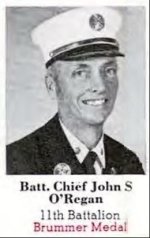
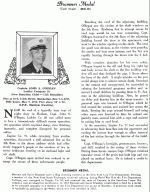
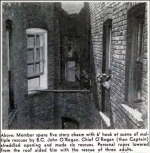
WNYF 1974 01 Progress Report Roof Ropes by Captain Luke M. Vaughn
On May 7, 1973 Ladder Co. 26-1 responded to Box 7-5-1377 at 0802 hours. Captain (now Battalion Chief) John O'Regan, accompanied by Fr. Bernard and Fr. Seaman went to the roof of the fire building at 25 East 115th Street. From this point, they observed smoke billowing from the 5th floor window facing on to an interior shaft between the fire building and Exposure #3, 1756 Madison Ave. Framed in one window was Mrs. Mary Ballet, aged 20, and huddled about her, Terence and Terry Mitchell, each aged 3, and Andre Mitchell, aged 10. At the next window. stood Ronald and Andre Jones, ages 30 and 21 respectively. Both were in an extreme state of panic due to the untenable nature of their position. It appeared very likely they were about to jump into the five story shaft. The time element was critical!
Crossing to the roof of the exposure building, Captain O'Regan with Firemen Seaman and Bernard, descended to the top floor apartment facing the fire apartment windows. Captain O'Regan climbed out on to the window ledge opposite Mrs. Ballet and the children. With the two firemen holding his left foot firmly on the ledge, Captain O'Regan lunged across the shaft placing his right foot on the ledge near the woman and three children, (See diagram.) He quickly handed the three small children (Andre Mitchell weighed 85 lhs.) across the shaft to the firemen in the other window as he spanned the 54 inches across the five story shaft. He then turned his attention to Mrs. Ballet.
Other members of Ladder Co. 26-1 had, meanwhile, arrived at the roof above and had lowered their 40 foot Personal Ropes near to where Captain O'Regan was perched. Grasping the hook end of the 3S inch Nylon rope, he placed it around Mrs. Ballet. Assisted by the firemen on the roof holding her weight, Captain O'Regan guided the woman across the shaft to safety. Ronald and Andre Jones anxiously awaited rescue in the next window.
To reach the two men in the other window. it was necessary for Captain O'Regan to shuffle forward on the two ledges. Captain O’Regan was forced to exercise some restraint on one of the men who had become extremely panicky. Grasping another Personal Rope lowered from above, he secured the man who was promptly pulled up to the roof. At this point, Captain O'Regan heard Engine Co. 91 -1 in the hallway and kept the second man under control until assistance arrived from inside. Captain O'Regan's comment was short but eloquent: "If those ropes were not available to be lowered from the roof, there would almost certainly have been a loss of life."
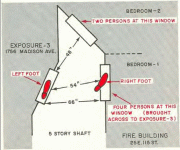
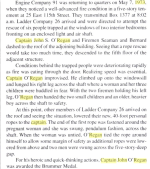
- from Fire Department, City of New York by Paul Hashagen
Appointed to the FDNY on March 16, 1951, retired after serving 32 years on March 17, 1983 with rank of Battalion Chief. Awarded the FDNY Betram Brummer Medal in 1974.
FF O'Regan's grandfather, Patrick L. O'Regan, arrived from Ireland in 1884 and was the first member of the family to join the Department in 1898 and served for twenty years, retiring with the rank of Acting Battalion Chief. FF O'Regan's father, George P. O'Regan, joined in 1929 and became Lieutenant of Ladder Company 80. FF O'Regan's brothers William and George were also NYC firefighters. (George was killed as a result of Hurricane Sandy in 2012.) His son John became the fourth generation of the family in the FDNY, assigned to Engine 77. Brother George's son became a firefighter in New Jersey.

 www.nycfire.net
www.nycfire.net
Ladder 26 medals:
CAPT JOHN S. O'REGAN LAD. 26 MAY 7, 1973 1974 BRUMMER



WNYF 1974 01 Progress Report Roof Ropes by Captain Luke M. Vaughn
On May 7, 1973 Ladder Co. 26-1 responded to Box 7-5-1377 at 0802 hours. Captain (now Battalion Chief) John O'Regan, accompanied by Fr. Bernard and Fr. Seaman went to the roof of the fire building at 25 East 115th Street. From this point, they observed smoke billowing from the 5th floor window facing on to an interior shaft between the fire building and Exposure #3, 1756 Madison Ave. Framed in one window was Mrs. Mary Ballet, aged 20, and huddled about her, Terence and Terry Mitchell, each aged 3, and Andre Mitchell, aged 10. At the next window. stood Ronald and Andre Jones, ages 30 and 21 respectively. Both were in an extreme state of panic due to the untenable nature of their position. It appeared very likely they were about to jump into the five story shaft. The time element was critical!
Crossing to the roof of the exposure building, Captain O'Regan with Firemen Seaman and Bernard, descended to the top floor apartment facing the fire apartment windows. Captain O'Regan climbed out on to the window ledge opposite Mrs. Ballet and the children. With the two firemen holding his left foot firmly on the ledge, Captain O'Regan lunged across the shaft placing his right foot on the ledge near the woman and three children, (See diagram.) He quickly handed the three small children (Andre Mitchell weighed 85 lhs.) across the shaft to the firemen in the other window as he spanned the 54 inches across the five story shaft. He then turned his attention to Mrs. Ballet.
Other members of Ladder Co. 26-1 had, meanwhile, arrived at the roof above and had lowered their 40 foot Personal Ropes near to where Captain O'Regan was perched. Grasping the hook end of the 3S inch Nylon rope, he placed it around Mrs. Ballet. Assisted by the firemen on the roof holding her weight, Captain O'Regan guided the woman across the shaft to safety. Ronald and Andre Jones anxiously awaited rescue in the next window.
To reach the two men in the other window. it was necessary for Captain O'Regan to shuffle forward on the two ledges. Captain O’Regan was forced to exercise some restraint on one of the men who had become extremely panicky. Grasping another Personal Rope lowered from above, he secured the man who was promptly pulled up to the roof. At this point, Captain O'Regan heard Engine Co. 91 -1 in the hallway and kept the second man under control until assistance arrived from inside. Captain O'Regan's comment was short but eloquent: "If those ropes were not available to be lowered from the roof, there would almost certainly have been a loss of life."


- from Fire Department, City of New York by Paul Hashagen
Appointed to the FDNY on March 16, 1951, retired after serving 32 years on March 17, 1983 with rank of Battalion Chief. Awarded the FDNY Betram Brummer Medal in 1974.
FF O'Regan's grandfather, Patrick L. O'Regan, arrived from Ireland in 1884 and was the first member of the family to join the Department in 1898 and served for twenty years, retiring with the rank of Acting Battalion Chief. FF O'Regan's father, George P. O'Regan, joined in 1929 and became Lieutenant of Ladder Company 80. FF O'Regan's brothers William and George were also NYC firefighters. (George was killed as a result of Hurricane Sandy in 2012.) His son John became the fourth generation of the family in the FDNY, assigned to Engine 77. Brother George's son became a firefighter in New Jersey.

FDNY and NYC Firehouses and Fire Companies - 2nd Section
Engine 58/Ladder 26 (continued): Ladder 26 medals: FF THEODORE N. DURANT LAD. 26 NOV. 18, 1965 1966 SCOTT FF SAMUEL J. MITCHELL, JR. LAD. 26 APR. 13, 1966 1967 FDR FF JOHN J. MASSARO LAD. 26 NOV. 15, 1967 1968 BROOKMAN FF Massaro rescued 3 children from a burning 3rd floor...
 www.nycfire.net
www.nycfire.net
Last edited:
- Joined
- Apr 23, 2018
- Messages
- 1,174
Tally Ho Ladder 114 covered the Sunset Park of Brooklyn. In Sunset Park, minority groups make up the majority of the population. Nearly half of the area’s inhabitants are Latino, while roughly 40% of the people come from Asia, making for a diverse melting pot of ethnic eateries and cultural businesses.
One of Ladder 114's unique company traditions has the officer saying grace before the company meal, even if you're the covering boss for the day. After eating, members remain at the table to socialize before cleaning up.
John Drennan promoted from L 114 was fatally injured at the Watts Street Fire as the Captain of Ladder 5. L 114 Lieutenant Dennis O'Berg probationary firefighter son was killed on 9/11. I worked alongside Dennis at the WTC site many times, he was one of the "Band of Dads."
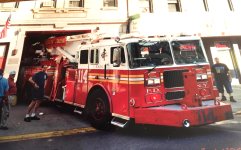
One of Ladder 114's unique company traditions has the officer saying grace before the company meal, even if you're the covering boss for the day. After eating, members remain at the table to socialize before cleaning up.
John Drennan promoted from L 114 was fatally injured at the Watts Street Fire as the Captain of Ladder 5. L 114 Lieutenant Dennis O'Berg probationary firefighter son was killed on 9/11. I worked alongside Dennis at the WTC site many times, he was one of the "Band of Dads."


